By Amy Phillips
John Franklin Corbett was a founding member of both Arland and Meeteetse. Corbett was born in Massachusetts to Matthias and Johanna Corbett soon after the couple immigrated to the United States from Ireland.
Genealogy records of Corbett are rare until he settled in Meeteetse, but a biography published by A.W. Bowen in 1903, Progressive Men of Wyoming, provides more insights into Corbett’s youth. According to the biography, published during Corbett’s lifetime, he tried to enlist in the Union Army but was rejected on the grounds of his health. Despite this, he became a freighter for the Army and made his way to Kansas City, Missouri and then to Lawrence, Kansas. According to Bowen, “He scouted with many noted personages, portions of the time being in the service of the United States, and portions in that of the several territories and of private parties. He also hunted buffalo and other game on an extensive scale.”
Corbett’s death notice published in The Park County Enterprise on December 17, 1910 adds to this background, “He was engaged in the Government service on the Platte and Arkansas rivers in Colorado, in 1864, and continued in this capacity and in hunting until 1873, at which time he passed into the Western part of Nebraska, later going to Montana, hunting buffalo for hides in the early seventies, coming to the Big Horn Basin in 1877, for the first time and coming here permanently in 1880.”
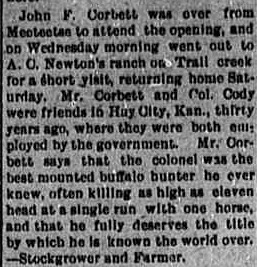
Figure 1. Big Horn County News mentioned the connection between John Corbett and Colonel William Cody on December 6, 1902.
Confirmation of Bowen’s account also comes from a newspaper article published in Big Horn County News by way of the Wyoming Stock Grower on December 6, 1902 which stated that Corbett and Colonel Cody knew each other in Kansas City when both were employed by the government (Figure 1).
According to Bowen, Corbett came to Wyoming by way of Cheyenne where he served as a store clerk before going to the Powder River. Bowen writes, “But he tired of this life at last, and, on September 10, 1880, he came to the Bighorn basin determined to settle down to more quiet pursuits.”
Josh Deane, early mail carrier in the Basin, claimed in his autobiography Mayor of Meeteetse to have first met Corbett when establishing his mail route in 1877:
“Here I met John Corbett, an old buffalo hunter and a very recent arrival in the Basin. He had been in the West for some time, hunting buffalo, doing freighting at Powder River, helping build Fort McKinney, and supplying game to the post at Fort Custer, from which place he had come to Trail creek to start a horse ranch.”
A notice of John Corbett’s death published in The Basin Republican on December 23, 1910, also placed Corbett in the Basin by 1877, “In 1877 he established the first trading post in the Big Horn Basin, on Trail creek, now the Newton ranch, near Cody.” The 1880 Census showed Corbett at Fort Custer, Montana though Deane claimed to have met him three years prior already in the Bighorn Basin. It could be that Corbett didn’t establish his trading post until 1880, shortly after the census was taken.
Deane’s description of Corbett continues:
“He had just finished building a large dugout and log cabin, which was a hangout for soldiers who had deserted, and a trading post for the Indians. I have never gone to Corbett’s without finding a number of men there, usually both whites and Indians. The ostensible employment of the white men was trapping and hunting, drying sheep and buffalo meat, and packing it to the steamboat line at Coleson, (now Huntley) Montana, at the mouth of Pryor creek. Their real occupations seemed to be gambling and selling ‘red water’ to the Indians. On later trips, I packed in many gallons of the ‘Indian medicine’ for Corbett.”
According to Bowen, Corbett ran the trading post for four years before moving to the head of Meeteetse Creek. This time, Corbett’s new venture included a partner by the name of Victor Arland. Deane wrote:
“John Corbett, whom I met at his establishment on Trail creek, early in my mail carrying days, had acquired in 1880 a partner, Victor Arland, recently of France and more recently of the Black Hills and Fort Custer. Arland wished to erect a fitting monument to his name and at the same time, to make more money than he could at hunting buffalo and selling red water to the Indians. He thought he saw the need for a town in the Meeteetse region. His thought gave birth to Arland. By 1887, it consisted of a restaurant, rooming house, bar room, store, and postoffice. The postoffice, store, and saloon were all in one building. There was also a dance hall, where George Marquette used to play. Corbett continued to reside on Trail creek but came frequently to visit his partner and note the progress of the business.”
On August 3, 1882, The Billings Herald published an article mentioning John Corbett. The editor of the paper and Corbett had conversed the day before the publication and the editor wrote,
“Mr. Corbett resides 115 miles south of us near Trail Creek, where he owns and operates a large ranch. He informs us, and by the way furnishes names of scores of ranchmen and cattle owners living in his vicinity who are all expecting to make Billings their headquarters when supplies run short, and who will drive their cattle here for shipment. Mr. Corbett has just sold a large ranch situated on Trail Creek to a French cattle company headed by Comte Ivan du Dore, which already has 12,000 head of cattle and horses on the property.”
We find more information about the ranch sale in a letter written by Victor Arland and housed at the McCracken Research Library, Buffalo Bill Center of the West. On March 1, 1882, Arland wrote:
“Lately, a Frenchman, Count Ivan du Dore who had come to America to hunt, was struck by the great advantages that the raising of cattle in the neighborhood of the Eocheures [sic] offer. Since he is very enterprising, he bought a large number of cows and entrusted his brother, who had come with him, to return to France to bring back some capital. Then he began to hunt for a suitable place. In the course of his research, he learned where I was living and came to pay me a visit. Since the ranch I had built pleased him, he bought it from me for $600.00, the price that I was asking for it … When in September, 1880, my partner, J. Corbett, and I came to Trail Creek, we were very far from civilization. Now, civilization is coming to find us, with big steps. Next summer the Northern Pacific will be on the Yellowstone, up to Coulson, 125 miles direct from our place … Now we are running a little store to supply the needs of hunters and trappers of this region and of the Indians—Crows and Shoshones—who are hunting in this vicinity. Since this little business promises to do well, I am going to remain here for some time yet, perhaps a year or two.”

Figure 2. Map showing where John F. Corbett’s patent on Trail Creek near Rattlesnake Mountain was located.
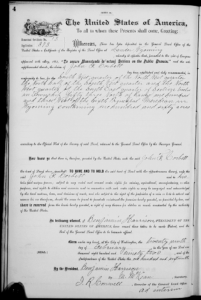
Figure 3. Image of the patent for John F. Corbett, courtesy of the BLM records which can be found here.
However, Corbett was issued a patent on February 29, 1892, for the land of his Trail Creek ranch which is near the base of Rattlesnake Mountain outside of Cody, Wyoming (Figure 3) that The Billings Herald claimed he sold to du Dore. It is possible that Corbett sold the ranch to du Dore, but du Dore was unable to meet the requirements of the sale and Corbett took over the land at that point. It is also possible, that Corbett sold half of his property but not the entirety and still received the patent on the portion he had not sold to du Dore.
According to Appointments of U.S. Postmasters 1832 – 1971 volume 82, Corbett was appointed as the postmaster of Arland, Wyoming on November 10, 1885. Victor Arland wrote about the appointment in his February 25, 1886 letter to Mr. Camille Dadant, “J. Corbette has been appointed postmaster, but since it is I who do all this work as well as the work of the agency of the Express Co., there are days when I will have far too much work to do.”
We learn more about Corbett and Arland’s partnership through an essay written by Camille Pierre Dadant in 1925. Dadant wrote of Arland’s murder in Red Lodge, Montana, “The information was conveyed to us in a very short letter by his partner and friend, J. Corbett. The latter was not a capable business man and the establishment was abandoned. Corbett and Arland were very devoted to each other, having saved one another’s life several times.”
Victor Arland was murdered in Red Lodge, Montana on April 24, 1890. It seems that after his death, Corbett moved to Meeteetse. Bowen wrote, “In 1890 he took up his residence at Meeteetse, and he has since then made that town his home. He owns much valuable property within its limits, and, also, much at Corbett which was named in his honor.” Despite the change in address, Corbett continued to be an active businessman which included his interests in Arland.
One article published in the Red Lodge Picket on February 13, 1892, reads, “We have a letter from Capt. John F. Corbettt, of Arland, and he informs us that if the business men of Red Lodge build a bridge over Clark’s Fork river and put the wagon road in passible shape that they will surely get the trade from the Bighorn Basin.”
Corbett, during this period, is an active businessman looking out for his investment in Arland. A year later, The Helena Independent published an article on January 9, 1893:
“J.F. Corbett, of Arland, Wyo., called at the Picket office Monday and emphatically denied the report published in the press, and copied in this paper last week, of killing a half dozen officers and cattle rustlers in the Big Horn basin recently. Mr. Corbett says that everything is quiet in that section at present and has been for some time past. ‘Such reports only injure the country,’ said Mr. Corbett, ‘and keep people from coming in. Asa Sehook, who the papers say is a cattle thief, and was killed at the head of NoWood, is a good, honest man, and is alive and well, and Bill Nucher, also reported as killed, is now above the N bar ranch on Owl Creek.’”
On February 27, 1892, The Red Lodge Picket wrote, “We have a spicy letter in this issue written by Capt. John F. Corbett or Arland, Wyoming. It is always a pleasure to publish a letter from Capt. Corbett, as we well know that it will be perused by our readers with the greatest avidity.” The mentioned letter is an (extremely elaborate) attempt by Corbett to advertise the mining prospects on the Wood River and can be found here.
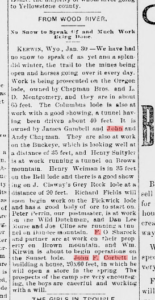
Figure 4. Red Lodge Picket February 11, 1893 mentioned John Corbett building a store at Kirwin.
Once again it seems Corbett’s endorsement was based on his business interests. The Red Lodge Picket published a notice (Figure 4) on February 11, 1893, under the column “From Wood River” that, “John F. Corbett is building a house, 20 x 60 feet, in which he will open a store in the spring.” The store was located at Kirwin where William Kirwin had begun operations on the Sunset lode.
In 1895, Corbett married Mrs. Mary Josephine Wing Niles. A divorcee, Mary Josephine and her sons came to Wyoming by way of Minnesota and Iowa. The couple married in either Red Lodge, Montana or Lander, Wyoming (newspaper clippings mention both locations, Figures 5 and 6).

Figure 5. The Wind River Mountaineer published on November 6, 1895 that John Corbett and Mary were married in Red Lodge, Montana.

Figure 6. The Red Lodge Picket published on December 28, 1895 that John and Mary Corbett were married in Lander, Wyoming.
In 1896, Mary opened the Meeteetse Hotel where the current fire hall stands on the southeastern corner of Park and State Street. The couple is found together on the 1900 Census living in Meeteetse; however, their marriage was short-lived. On November 5, 1901, Mary married Edward Blake. Though John and Mary must have obtained a divorce between the 1900 census and November 1901, the Museums was unable to find that record.
John Corbett continued to live in Meeteetse until his death in 1910. The Park County Enterprise published his death notice with the endorsement:
“John Corbett, was peculiarly one of the most interesting men that it’s been the privilege of the writer to know in the last quarter of a century in the Big Horn Basin, particularly so on the account of the fact, that his mind was stored with all the richness of the west as it appeared to him after having lived therein for a longer period of time than most men expect to live on earth … Mr. Corbett has lived at Meeteetse for the past fifteen years, and as most all of the old timers, had acquired but little worldly wealth, having been liberal to a degree with all whom he came in contact.”
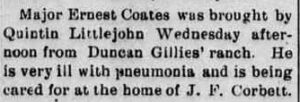
Major Ernest Coates is cared for at the home of J.F. Corbett, notice published in The Cody Enterprise on February 7, 1907.
We get a glimpse of this generosity when, in February of 1907, Major Ernest Coates is cared for at the home of Corbett during his illness with pneumonia (Figure 7). Corbett was also a member of the Meeteetse Old Timers Club, Woodman of America, and the Republican Party. The year following his death, Alex A. Linton sold his property which consisted of 6 lots in Meeteetse (Figure 8).
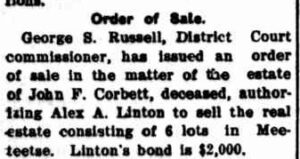
Figure 8. Notice of the order of sale for John Corbett’s property published in The Powell Tribune on June 3, 1911.

